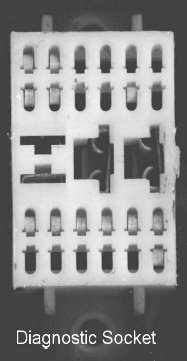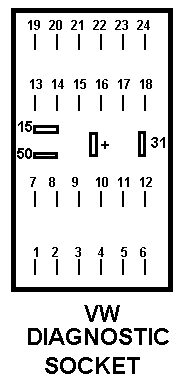 What Is This Plug In My Engine
Bay?
by Jim
Mais © 1999
What Is This Plug In My Engine
Bay?
by Jim
Mais © 1999
 What Is This Plug In My Engine
Bay?
by Jim
Mais © 1999
What Is This Plug In My Engine
Bay?
by Jim
Mais © 1999
The plug (actually "socket") was introduced mid-year on 1971 Type 1, 2, 3 and 4 cars. It was connected to various electrical points in the car which enabled a computer at the VW dealership to "diagnose" the performance or malfunction of certain engine/electrical characteristics.
Many changes were made during the few years the plug was in existence. If
your wiring is not exactly as shown in the diagrams, it is likely that a
feature was added or removed.
The diagrams are specific for the Type I (Beetle, Ghia and THING) but
should be correct for the other cars as well.
The items monitored were:
Rear lights: (Tail, Brake, Turn) The tail light connection was dropped
later.
Rear window defogger.
Battery condition and charging circuit.
Engine compression.
Ignition Timing.
 PIN NUMBERING
PIN NUMBERING
I have shown the actual wiring on two separate diagrams,
one for generator equipped cars
![]()
and one for alternator
![]()
Pins 9, 10, 11 and 12 are connected to the tail, turn signals, and brake light wiring. Note that the computer could only tell whether voltage was reaching these lights; not whether the lamp was burned out or not. (It would be possible to monitor current draw via the battery ground strap shunt, but I don't know whether this was actually implemented.)
Similarly, the connection to the rear window de-froster relay (pin 5) only told whether the relay was supplying power to the heating element.
Various checks could be made on the battery circuit. The open-circuit voltage is measured from pin 31 to pin +. With the engine running, charging voltage could be measured. It was also possible to apply external load currents while observing the battery voltage.
Generator (or alternator) charging current was obtained by measuring the voltage drop across a specific length of wire. The ends of this wire were connected to pins 6 and 14. On the generator, this wire is the one running from D+ to the regulator. On alternators, the wire runs from B+ to the battery wire splice.
Battery electrolyte level was checked by means of a special probe built
into one of the battery center cells. (Try and find one of
those today!)
The probe is brought out to pin 7.
The battery ground strap has two wires attached to its ends and going to
pins 8 & 17. These connections measured the voltage drop
across the strap when the starter motor was cranking the engine. (The
computer could operate the starter by applying power to pin 50.)
The computer would "see" a series of current spikes corresponding to the
compression stroke of each cylinder in turn. The magnitude of these
current pulses was translated into rough values of compression pressure and
used as a measure of engine condition.
Engine idle RPM could be calculated from pulses received at pin 13 (from the points opening and closing). Point dwell was also estimated from this signal.
A hand-held timing light could be used to check the timing setting.
In late '71 or early '72, a small pulse transformer was added to the
#1 spark plug wire and produced a signal when #1 plug fired.
This signal was fed to pins 19 & 20.
The transformer is pictured here
![]() .
.
There is no physical connection to the plug wire; current flowing through
the plug wire merely induces a voltage pulse in the transformer winding.
Beginning in '74, a sensor was added behind the flywheel to detect TDC.
As far as I know, this sensor was a variable reluctance type of pickup.
The flywheel had a steel pin on its back side which swept past the pickup
face to create the pulse.
The combination of the TDC sensor and the #1 plug wire pickup allowed the computer to accurately determine initial timing setting and even to observe timing advance with speed change.
Epilogue
The diagnostic program was quietly dropped in the late 70's; I don't have an exact date. There must have been considerable production cost involved in all the special wiring and sensor devices. It's doubtful whether the program ever had any significant effect on sales.